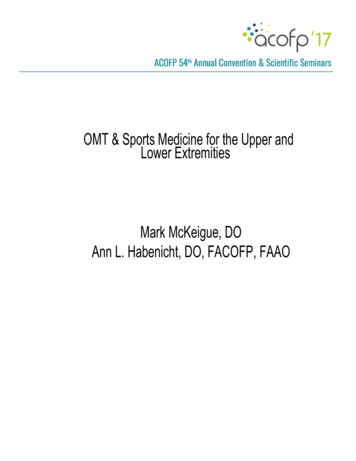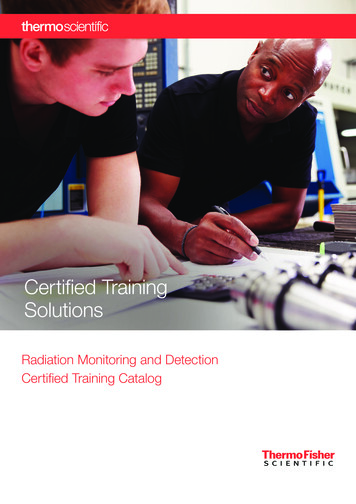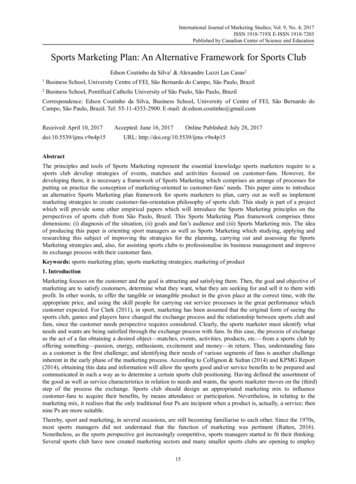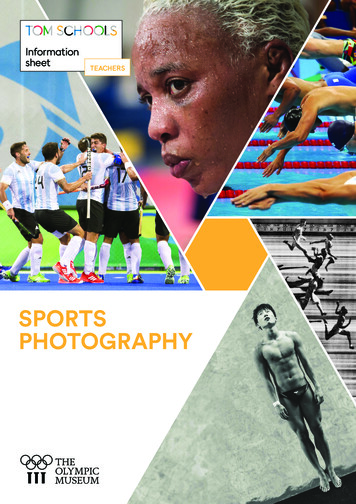
Transcription
ACOFP 54th Annual Convention & Scientific SeminarsOMT & Sports Medicine for the Upper andLower ExtremitiesMark McKeigue, DOAnn L. Habenicht, DO, FACOFP, FAAO
3/7/2017OMT & SportsMedicine for theUpper and LowerExtremities, ACOFP,March 16, 2017MARK E. MCKEIGUE, D.O., FAOASMPROFESSOR, OSTEOPATHIC MANIPULATIVE MEDICINEMIDWESTERN UNIVERSITY, DOWNER’S GROVE, ILLINOISOBJECTIVES To present a case and review a differential diagnosis; first for theupper, and then the lower extremity To review the involvement of the cervical spine, thoracic outlet,rotator cuff, elbow, carpal tunnel and the TFCC as the etiology ofour patient’s symptoms. To review the pertinent anatomy of the extremities. To review “special tests” used to make a diagnosis. To discuss the use of Osteopathic Manipulative Treatment (Dr.Habenicht) in addition to PPPRICEMM(M) (Dr. McKeigue)1
3/7/2017Special Thanks Kurt P. Heinking, D.O., FAAO Chair, Department of Osteopathic Manipulative Medicine, ChicagoCollege of Osteopathic Medicine, Midwestern University My Former Resident! My Former Fellow in Sports Medicine My current Boss 2
3/7/2017 CC: A 40 year old female triathlete presents to your officecomplaining of “ Numby, tingly, funny feelings in my right arm andshoulder.” HPI: She’s had this on and off for 18 months or so, but it seems to bebothering her more lately. Occasionally it awakens her from sleepand sometimes it effects her grip on her bike or on the bar whenlifting in the gym. She’s used OTC Advil, Tiger Balm and Biofreeze with equivocalresults.Macro Trauma?3
3/7/2017Micro Trauma?Acute or Chronic? Little League . Ultra-marathon .4
3/7/2017History and Physical Examination 5feet, 7 inches ( 67” 1.7018 meters),145# ( 65.9 kg). BMI 22.75 Temp:97.9; BP 110/70; P 62; R 12. Goodcolor; in NAD. HEENT: ChestWNLclear; Cor RRR; Abd negDiagnosis of the Cervical Spine5
3/7/2017Structural ExamAROM /PROM cervical (1st visit)6
3/7/2017Range of Motion Range of Motion of CervicalSpine Flexion/extension – 130o. Side bending (lateral flexion)35o left and right.Rotation - 90o left and right.KENActive and Passive ROMSoto- Hall testO’Donoghue test Chin tucked Head tilted to side Hand on sternum Hand on zygoma and temple Pain with Active flexion muscular etiology Pain with Active flexion muscular etiology Pain with Passive flexion vertebral /ligamentous etiology Pain with Passive flexion vertebral /ligamentous etiology7
3/7/2017Neurologic levelsNeurology of Upper Extremity8
3/7/2017Upper Extremity DermatomesNeurology of the Upper Extremity9
3/7/2017Spurling Test Goal: To assess cervicalradiculopathyPatient Position: Seated.Examiner Position: The test ispeformed in three stages. First axial compression isapplied with the neck inneutral. Then the neck is extended andaxial compression is applied. Finally, the neck is extendedand rotated the affected sideand axial compression isapplied. The neck may alsobe sidebent to localize thesymptoms.Positive Findings: A positive result isindicated if the patientexperiences pain down into thearm on the same side as thecompression.Cervical distraction can also be usedFindings 2/4reflexes bilat B, Br, T WeaklyPos Spurling’s on the right DecreasedCervical ROM ForwardHead WorkingDx: Cervical Radiculopathy(M54.12) Tx:OMT (Dr. Ann)10
3/7/2017DeKline TestBut I was wrong! It wasn’t a CervicalRadic So Now what?Neurogenic?Venous?Arterial?11
3/7/2017Lhermitte’s Sign Goal: to identify spinalcord, upper motorneuron lesions, or duraltension.Patient Position: Longsitting position.Examiner Position: Theexaminer flexes thecervical spine whilesimultaneously flexingone hip.Positive Findings: Painshooting down thespine and into theupper or lowerextremities.12
3/7/2017A-P Curve Problems Reversal of the normalcurvature places unduestresses on jointsand tissues. May be a long-standingpostural change tonociceptive orviscerosomatic input.Lordosis at T5-7Thoracic Outlet Syndrome (TOS) 353.0 Neckpain Shoulder Armpainpain, heaviness, clumsiness Numbnessand tingling of the fingers ImpairedCirculation to the Extremities(causing discoloration)13
3/7/2017Adson Test Goal: to test for thoracicoutlet syndromePatient Position: Thepatient is seated androtates the head to theaffected side.Examiner Position: Theexaminer palpates theradial pulse and theninstructs the patient toextend the head and takein a deep breath and holdit. The examiner thenextends and externallyrotates the arm.Positive Findings: Theexaminer identifies thedisappearance of theradial pulse.Halstead Test Goal: to test for thoracicoutlet syndrome Patient Position: The patient isseated and rotates the headto the affected side. Examiner Position: Theexaminer palpates the radialpulse and then instructs thepatient to extend the headand take in a deep breathand hold it. The examinerthen extends and externallyrotates the arm. Positive Findings: Theexaminer identifies thedisappearance of the radialpulse.14
3/7/2017Elvey Test Brachial Tension Test Depression and abductionof the shoulder in thesupine position Extension of the wrist Stretches dura, & nerverootCan also be done seated,depress shoulder, extend wristOther TOS tests RoosTest Wright’sTest (a 2-step test) Hyperabduction TOSTest(Modified) Allen’s test15
3/7/2017Roos TestWright’s (Hyperabduction) Test16
3/7/2017The 3 most common places for theSubclavian Artery (TOS) impingementare: 1:Between the Anterior and MiddleScalenes 2:Between an “extra” or “cervical rib”and the first rib 3:Under a tight Pectoralis Minor muscleTOS Treatment? OMT(Dr. Ann)17
3/7/2017But, wrong again, it’s not TOS So,Moving on Down and out to theShoulder itself 3Joints (GH, AC, SC) 1Articulation (Scapulothoracic)2 Things to make me think it’sRotator Cuff Tendonitis M75.10 Vaguepain that awakens the patientfrom sleep Tipof the Deltoid: the referred spot forpain coming from the Supraspinatous18
3/7/2017Anatomy Review: ShoulderRotator Cuff19
3/7/2017Special Tests Adson’s – Thoracic OutletSyndrome Drop Arm – Rotator Cuff Tear;supraspinatus weakness Apley’s Scratch – Rotator CuffDysfunction Apprehension – Anterior GHInstabilityEmpty Can – Rotator Cuff Tear;Suprascapular NerveEntrapment or Neuropathy Hawkin’s – Supraspinatustendon impingement Cross-arm – AC JointInflammation Clunk – Glenoid Labrum TearSpecial Tests Neer’s – Subacromialimpingement Spurling’s – Cervical nerve rootimpingement or inflammation Relocation – Anterior GH jointinstability Sulcus sign – Inferior GH jointinstability Scapular winging – Serratusanterior weakness or injury Yergason’s – Biceps tendoninstability or tendonitis Speed’s – Biceps tendoninstability or tendonitis20
3/7/2017 a.Empty Can / Drop Armtests the integrity of thesupraspinatus muscle b. patient position – seatedwith arm at shoulder level at45 degree angle from body,thumb pointing down c. examiner exertsdownward force on forearmswhile pt. maintains startingposition (compare bilaterally) d. if pt. is unable to assumestarting position (withoutexaminers force), the arm justdrops to the side (Drop Arm)and confirms complete tearof supraspinatusScapulo-thoracic Rhythm During the first 200-300 ofshoulder abduction, thescapula is stable. After this, the scapula shouldmove 10 for every 20 ofglenohumeral motion. This isthe scapulo-thoracic rhythm. If this sequence is disrupted,dysfunction of the upperextremity will occur. This is one of the primary waysaxial spine or thoracic cagedysfunction affects extremitydysfunction.21
3/7/2017Subacromial Impingement Etiology Primary extrinsic(coracoacromial arch)Subacromial spurAcromioclavicular jointOACoracoacromial (CA)ligamentVariation in size andthicknessCalcification/ossificationless commonType III (hooked)acromionSubacromial ImpingementMRI Best diagnostic clue: Hooked acromion on sagittalimages with supraspinatusgeneration /- Reactive bursitis (bursafluid) Location: Osseous acromialoutlet22
3/7/2017Shoulder: Rotator Cuff Tendinosis Structures Injured:Supraspinatus,Infraspinatus, Teres Minor,or Subscapularis tendon.Mechanism of injury:micro trauma secondaryto poor shoulder posture/ mechanics.Special Tests: Neer,Kennedy-Hawkins, EmptyCan (Jobe’s Sign), PainfulArc, Scapular Lift Off TestRotator Cuff Partial ThicknessTear Three types of partial tears ofRTC Articular surface partial tear– most common, associatedwith classical impingement Interstitial – not seen atarthroscopy Bursal surface23
3/7/2017Rotator Cuff Partial Thickness Tear Partial tears are morepainful than fullthickness tears.Clinical profile: Athlete,patient after 40 yearsof age withimpingementMost partial tearsprogress to fullthickness tears within 2years.Scapular Dyskinesis: “Sick Scapula”Syndrome Abnormal motion and position of the scapula leading to abnormalkinematics of the GH and AC joints. Due to abnormal muscle activationClassification Type 1: Prominence inferior medial border Type2: Scapular malposition,Inferior border prominence, Coracoid pain,dyskinesia Type 3: Prominence of superior medial border, and rotator cuffpathology24
3/7/2017And once again, our treatmentstrategy is? It’sOMT time with Dr. AnnThe History, the History, andfurthermore, the History! “Uponfurther review, ” Ourtriathlete “forgot” to mention thatshe’s had a few falls!!!25
3/7/2017History FOOSH Injuries (Fall On an Out Stretched Hand)MVA’sMacro TraumaRepetitive OveruseAthletic Injuries Tennis Rock climbing Golf GymnasticsDifferential Diagnosis VINDICATES Pneumonic: Vascular Ischemia Hemarthrosis Avascular Necrosis Thoracic Outlet Syndrome Inflammatory Septic Joint Tendonitis Bursitis Ligament Sprain Adhesive Capsulitis Traumatic Arthritis26
3/7/2017Differential Diagnosis Neurologic (lesion) Neurologic (referred pain) CVA (i.e. stroke) Cervical radiculopathy Cervical lesion Internal organ disease Axillary nerve palsy Subscapular nerve palsy Brachial plexus palsy Multiple SclerosisDifferential Diagnosis DegenerativeFracture Dislocation Muscle Tear Labrum TearRheumatoid Arthritis Capsular Tear Systemic Lupus Instability Ankylosing Spondylitis Gouty ArthritisIatrogenic OsteoarthritisTrauma After SurgeryAutoimmune Endocrine Diabetes Mellitus27
3/7/2017Differential Diagnosis Somatic Somatic Dysfunction Muscle Imbalance Impingement Tendinosis Adhesive CapsulitisDifferential Diagnosis In general, pain with movement commonly indicates: Impingement Muscle spasm Inflammatory disordersPainless movement is indicative of chronic disorders typicallyrequiring rehabilitation and possibly repair of damaged structures28
3/7/2017Injuries – Elbow/ForearmThe Elbow29
3/7/2017Elbow/Forearm FunctionalAnatomy Consist of three joints: Ulnohumeral Major motions: flexion/extension Minor motions: adduction/abductionRadiohumeral Supination/pronationRadioulnar Supination/pronationElbow Diagnosis Check for bicep involvement/ CS Palpation of pronator teres If tight palpate R3-4 for dysfunctionMedial and lateral epicondyle If tight palpate R3-4 for dysfunction Check radial head Interosseous membrane / fascia30
3/7/2017Physical Exam – Elbow AROM & PROM Include ab/adduction and pronation/supination Elbow injuries result in flexion contractures Lateral & Medial Epicondyle Olecrenon & bursa Biceps tendon and triceps tendon Forearm tension31
3/7/2017LATERAL EPICONDYLITIS M77.11 Etiology Most commonsign/symptoms Overuse syndrome causedby chronic varus stressacross the elbowAdult patient with lateralelbow painEpidemiology Up to 50% of tennis players95% of reported cases ingeneral population otherthan tennis playersLATERAL EPICONDYLITIS Lateral epicondyle – originfor extensor carpi radialisbrevis, extensor digitorumcommunis, extensor carpiulnaris PIN passes deep to the“mobile wad of three”(brachioradialis, extensorcarpi radialis longus andextensor carpi radialisbrevis) PIN enters supinator (deepto ECRB) passing througharcade of Frohse32
3/7/2017OMT OMT Treat upper thoracic spine and ribs Subscapularis tenderpoint Ipsilateral 4th rib HVLA, CS Treat adducted ulna Treat pronator teres tension /tenderpoint Treat ERCB tenderpoint MFR of forearm fascia Diagnose and treat cervical spineThe Wrist The wrist contains threefunctional joints. Radiocarpal joint Midcarpaljoint Distal Radioulnar joint Contains the TriangularFibroCartilage Complex (TFCC)which transfers force between thedistal radius and the distal ulna.The true wrist joint is theradiocarpal joint33
3/7/2017The Wrist Carpal Tunnel Formed by carpalbones posteriorly andthe flexor retinaculumanteriorly. The tendons of thewrist, the flexors of thefingers, and themedian nerve runwithin the tunnel. Thelumbricals can alsobe found within thetunnel when the wristis flexed.Functional Anatomy34
3/7/2017The Wrist Tunnel of Guyon Formedby the hook ofthe hamate and thepisiform. The ulnar nerve andartery pass through thetunnel. Anatomic Snuffbox Foundon the lateralaspect of the wrist. Site of the body of thescaphoid.Physical Exam – Wrist AROM & PROM Include ab/adductionpronation/supinationSnuffboxAxial loadTFCC6 compartments (1st most common)Finklestein’sRadial pulseShuck test35
3/7/2017Functional AnatomyTFCCTriangular Fibrocartilage Tear S63.591A Etiology Forearm pronation Hyperextension of wrist rotational load Degenerative ulno-carpalabutment syndromeUlnar pain36
3/7/2017Triangular Fibrocartilage Tear Most common signs/symptoms: Ulnar wrist pain Loss of strength Painful DRUJ rotation Tenderness and pain over TFCTriangular Fibrocartilage Tear Traumatic tears morecommon 40 years Degenerative tears morecommon 40 years Best Imaging tool: MRhighly sensitive & specificfor fluid extension, TFCmorphology/tear pattern MRI : Best diagnosticclue: Direct extension offluid across TFC37
3/7/2017Carpal Tunnel Syndrome G56.00 Clinical symptom complexsecondary to compression ofthe median nerve at carpaltunnel. Flexor retinaculum transversecarpal ligament (TCL) Idiopathic – most common(associated with aging)Carpal Tunnel Syndrome Differential Diagnosis Colles’ fracture Inflammatory processes Rheumatoid arthritis Gout and pseudogout Amyloid Median nerve tumors38
3/7/2017Carpal Tunnel Syndrome Epidemiology 50% incidence duringlifetime Up to 100% incidencewith repetitive motionactivity Inflammation present inonly 10% Edema present in 85% Vascular sclerosis in 98% Age: Peak – 5th or 6thdecade Gender: F MCarpal Tunnel Syndrome Most common signs/symptoms: Numbness & tingling (mediannerve distribution) Thumb, index, middle fingers radial half of ring fingercommonly affected Increased nocturnal pain burning39
3/7/2017Carpal Tunnel Syndrome Physical Exam Muscle atrophy and lossof function late findingsOpponens weakness:Earlier findingAtrophy of Opponens:Late findingsMRI: Best diagnostic clue:Cross sectionalenlargement and hyperintensity of median nerveOMT OMT Treat upper thoracic spineand ribs! MRI study at CCOM Treat pec minor tenderpoint Treat cervical spine Treat abducted / adductedulna, and wrist (Still, MFR) OMT Improve supination of elbowif restricted MET40
3/7/2017De Quervain’s Tenosynovitis M65.4 “Washer woman’s” sprain,stenosing tenosynovitisTenosynovitis andtendonitis of first dorsalextensor compartmentFirst extensorcompartment – directlyover radial styloid processFibro/ osseous tunnel tubular passageway 2.5cm in length formed bygroove in radial styloid &overlying extensorretinaculumlDe Quervain’s Tenosynovitis Etiology Repetitive activities (chronicmicro-overuse) leading toincreased friction andinflammation Grasping Pinching Wringing41
3/7/2017De Quervain’s Tenosynovitis Most commonsigns/symptoms: Painat radial styloidPain increased with wrist& thumb motion Radiation of pain toradial side of forearm Swelling Positive Finkelstein test –not pathognomonic Age: 35 – 55 yearsGender: F: M 8 – 10:1De Quervain’s Tenosynovitis Trauma Racquet sports Golf – hyperabduction duringgolf swing Fly fishing Javelin & discus throwing42
3/7/2017OMT OMT Treat upper thoracic spineand ribs Treat lateral epicondyletenderpoint Treat thumb myofascialrestriction Treat abducted / adductedulna and wrist OMT Improve supination of elbowif restricted METIf I Only Knew 3 Techniques. AndOnly HVLAHad3 Minutes (or MET): T-L junction CS- Rib supine CS- Coracoid process43
3/7/2017Summary Ajoint above and a joint below? BALONEY! Ifyou want to sound all Sports Med CAQ-ish youhave to know a few special tests, BUT Agood DOc investigates UE complaints bychecking the LS junction! And the TL, and theCervico-Thoracic, and the C-Spine, and theThoracic Inlet/Outlet, and the Shoulder, Elbow,Wrist, Hand, and, and, and .References Madden, C.; Putukian, M; Young, C; McCarty, E. Netter’s SportsMedicine, Copyright 2010, Saunders, Philadelphia, PA. Stoller, D.W. ; Diagnostic Imaging Orthopedics, AMIRSYS, Salt LakeCity Utah, 200444
3/7/2017References OMM Lecture and Workshop notes 2010-2011 OMM Dept. Procedure manual OMM Board Review: John Copobianco, D.O. FAAO Netter’s Anatomy Madden, Christopher C.; Putukian, Margot; Young, Craig C.; McCarthy,Eric C.; Netter’s Sports Medicine, Saunders/Elsevier 2010 McKeag, Douglas B.; Moeller, James L.; ACSM’s Primary Care SportsMedicine, Second Edition; Lipppincott Wiliams & Wilkins 2007 Watkins, Robert G.; The Spine in Sports, Mosby 1996Chila, Anthony G.; Partnership with the AOA; Foundations ofOsteopathic Medicine; Third Edition, Wolters-Kluwer, Lippincott, Williams& Wilkins 2011References for Extremity OMT1.DiGiovanna E, Schiowitz S, Dowling D. An Osteopathic Approach to Diagnosis andTreatment. 3rd ed. Philadelphia, PA: Lippincott Williams & Wilkins;2005:409-5372.Carreiro, JE. An Osteopathic Approach to Children. London, England:Livingstone; 2003:189-214Churchill3.Rennie, P, Glover J, Carvalho, Key L. Counterstrain & Exercise: An Integrated2nd ed. Williamston, MI: RennieMatrix;2004:75-99, 123-149Approach.4.Seffinger M, Hruby R. Evidence-Based Manual Medicine: A Problem OrientedPhiladelphia, PA: Saunders; 2007:238-310Approach.5.Myers H. Clinical Applications of Counterstrain. Compendium ed. Tucson, AZ: OsteopathicPress; 2012:135-147, 185-2226.DeStefano L. Greenman’s: Principles of Manual Medicine. 4th ed.Lippincott Williams & Wilkins; 2011:390-475Philadelphia, PA:7.Nicholas A, Nicholas E. Atlas of Osteopathic Techniques. Philadelphia, PA: LippincottWilliams & Wilkins; 2012:124-136, 198-226, 323-337, 384-402, 433-436, 455-468, 525, 532-54945
3/7/2017 7 Range of Motion Range of Motion of Cervical Spine Flexion/extension -130o. Side bending (lateral flexion) 35o left and right. Rotation - 90o left and right. KEN Active and Passive ROM Soto- Hall test Chin tucked Hand on sternum Pain with Active flexion muscular etiology Pain with Passive flexion vertebral /ligamentous etiology











